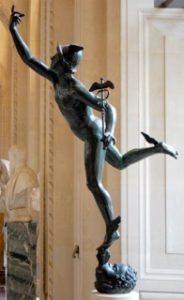 Many of the people I work with as a therapist and teacher express alarm, distress, fear, and disbelief over the course of political events that have taken place recently in the United States as well as on the world stage. Often I find myself pulled into these same feelings as I equivocate over what to say, how to say it, and to whom, under what circumstances. What is of interest and concern is how fragmented and ineffective language itself has become. Perhaps ineffective is the wrong word, since often the words of a politician or pundit can have a considerable effect. Words can inflame passions and lead to rancorous venomous exchanges between people. Language itself devolves from conversations about ideas and issues into sarcastic quips and personal insults aimed at maligning and discrediting anyone with a different view. What I’m describing is a crisis in communication. According to the pundits, the post-truth era is upon us, in which terms like “fake news” and “alternative facts” coincide with a spike in sales of George Orwell’s 1984, according to a recent NPR report (January 23rd, 2017). It seems to me, the current breakdown in language and communication provides an opportunity for some psychological curiosity and a chance to remember the sustaining nurturance in our relationship with dreams.
Many of the people I work with as a therapist and teacher express alarm, distress, fear, and disbelief over the course of political events that have taken place recently in the United States as well as on the world stage. Often I find myself pulled into these same feelings as I equivocate over what to say, how to say it, and to whom, under what circumstances. What is of interest and concern is how fragmented and ineffective language itself has become. Perhaps ineffective is the wrong word, since often the words of a politician or pundit can have a considerable effect. Words can inflame passions and lead to rancorous venomous exchanges between people. Language itself devolves from conversations about ideas and issues into sarcastic quips and personal insults aimed at maligning and discrediting anyone with a different view. What I’m describing is a crisis in communication. According to the pundits, the post-truth era is upon us, in which terms like “fake news” and “alternative facts” coincide with a spike in sales of George Orwell’s 1984, according to a recent NPR report (January 23rd, 2017). It seems to me, the current breakdown in language and communication provides an opportunity for some psychological curiosity and a chance to remember the sustaining nurturance in our relationship with dreams.
In the ancient world, the mysteries of language and communication were under the power of the god Hermes. Best known as the messenger of the gods with his emblematic winged sandals, helmet, and caduceus, Hermes held a special place in the Greek pantheon as the only figure capable of traveling from the heights of Mount Olympus to the depths of the underworld in Hades. In addition to language and communication, he was also the patron saint of liars, thieves, commerce, and travel, four other areas of timely interest and convergence in 2017. In his relationship to travel, he was also known as the god of the crossroads. As a divine traveler who was acquainted with the complexities of communication between different realms, Hermes was known as a psychopomp, one that leads the souls from the world of the living to their eternal place in the underworld. In this regard, he had a special relationship with dreams.
 The Homeric Hymn to Hermes (as cited in March, 1998) describes the god as “wily and charming, a thief, a cattle-rustler, a bringer of dreams, a spy by night, a watcher at the door” (p. 389). In the current stress and strain of a nation undergoing a profound transition in consciousness, awakening to new difficulties, facing challenges that often appear as an ethical call to declare what we stand for, it seems especially important to notice the mythic convergence we find between the images of communication, crossroads, and dreams. James Hillman (1979) gave particular attention to the relationship between dreams and the mythic underworld and to Hermes as the conduit that guides us into those nocturnal departures from the daily world of the living. What we find in dreams provides us with new perspectives, new insights, figures that re-present daytime worries in a different light. Sometimes we rediscover what we truly love or truly value, sometimes we find poison that paradoxically heals. In his brilliant essay, Apollo, Dream, Reality, Hillman (2007) cautions against the impulses of rationalism and literalism to reduce the meaning of the dream into a simple prescription we might employ to somehow better our daytime existence. He says, when we allow the dream to present itself just as it is, in its obscure and often baffling language speaking on its own behalf, then
The Homeric Hymn to Hermes (as cited in March, 1998) describes the god as “wily and charming, a thief, a cattle-rustler, a bringer of dreams, a spy by night, a watcher at the door” (p. 389). In the current stress and strain of a nation undergoing a profound transition in consciousness, awakening to new difficulties, facing challenges that often appear as an ethical call to declare what we stand for, it seems especially important to notice the mythic convergence we find between the images of communication, crossroads, and dreams. James Hillman (1979) gave particular attention to the relationship between dreams and the mythic underworld and to Hermes as the conduit that guides us into those nocturnal departures from the daily world of the living. What we find in dreams provides us with new perspectives, new insights, figures that re-present daytime worries in a different light. Sometimes we rediscover what we truly love or truly value, sometimes we find poison that paradoxically heals. In his brilliant essay, Apollo, Dream, Reality, Hillman (2007) cautions against the impulses of rationalism and literalism to reduce the meaning of the dream into a simple prescription we might employ to somehow better our daytime existence. He says, when we allow the dream to present itself just as it is, in its obscure and often baffling language speaking on its own behalf, then
Night has not yielded to daylight, and understanding now speaks with a darkened tongue: the devious occulted language of analogy, allusion and metaphor. Metaphor, says Vico, “confers sense and emotion on insensate objects,” so that every thing in the dream becomes a “miniature myth” (Vico’s definition of metaphor), full of analogous truths, restoring you, the dreamer to the underlying poetic imagination from which all mental life springs. (p. 332)
This mode of communication at the crossroads between that which is conscious and rational, and that other path which is baffling and obscure, is the privileged landscape of Hermes, the god of the crossroads. In sitting with “the underlying poetic imagination” of our dreams as living entities, perhaps Hermes will offer us some assistance at also learning how to sit with the confounding breakdown of our collective imagination and the modern crisis of communication. Perhaps this new era of post-truth and alternative facts doesn’t make sense precisely because it’s not supposed to make sense. Hermes traffics in ambiguity, trickery, and deception as well as communication.
The alchemists worshipped this same deity by his Roman name, christening him Mercurius Duplex. They understood the necessity of his twofold and twofaced nature. Hermes Pharmakon was another alchemical moniker, indicating his paradoxical powers to administer the poison that brings healing. The alchemical experiment couldn’t succeed without his blessing, although it was understood the god could deceive and confound just as easily as he could show favor on the opus. Stephen Aizenstat has said that when he is about to tend a dream, he routinely invokes Hermes to be with him. This is the type of invocation understood by the alchemists, submitting to the wiles of the divine messenger who can lead us to a place of understanding at the crossroads between the daytime language of reason and the nighttime language of dreams.
What I’m suggesting is not a simple prescription or an easily implemented solution. Rather, I’m suggesting that the underlying roots of the current crisis in communication find their way to a mythic archetypal source, which becomes familiar with the practice of conversing with the images of our dreams. For better or for worse, we are living in a hermetic age, and the way forward will be under the aegis of that charming cattle-rustler, the bringer of dreams, the one looking over us as we stand at the crossroads.
Reference List
Hillman, J. (1979). The dream and the underworld. New York: Harper & Row.
Hillman, J. (2007). Apollo, dream, reality. In Mythic figures (pp. 320-335). Putnam, Conn.: Spring.
March, J. (1998). Cassell’s dictionary of classical mythology. London, UK: Cassell.
